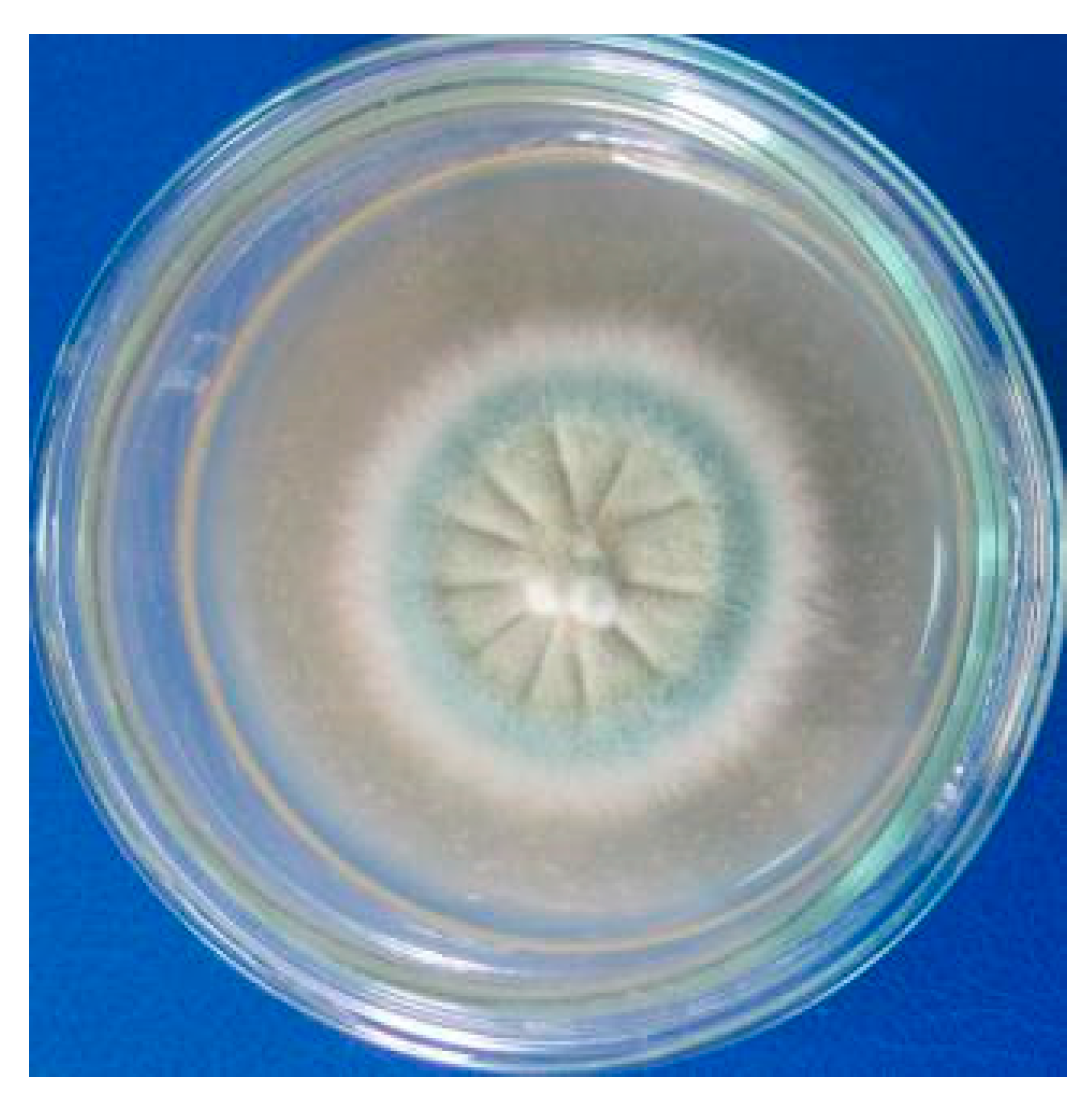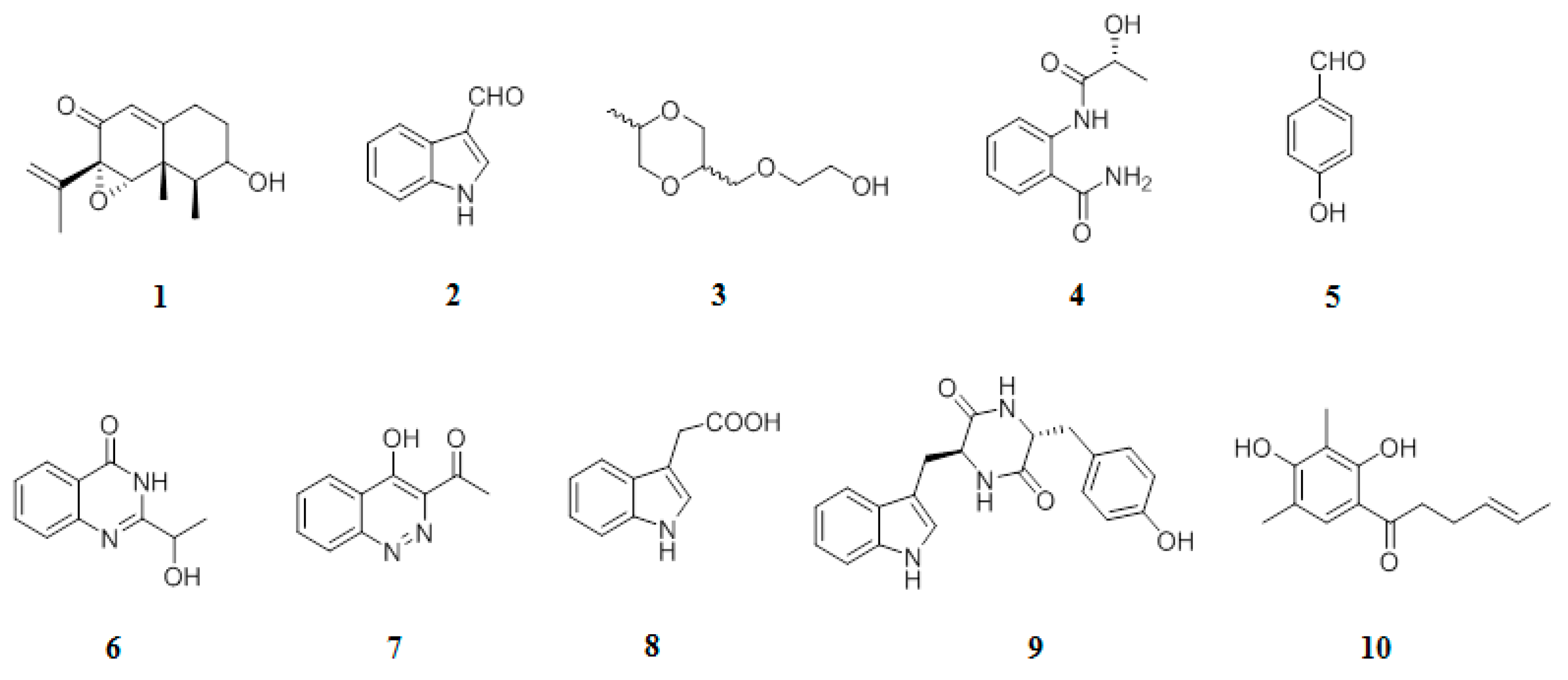Chemical Composition and Biological Activities of Metabolites from the Marine Fungi Penicillium sp. Isolated from Sediments of Co To Island, Vietnam
Abstract
:1. Introduction
2. Results and Discussion
2.1. Identification of Fungus
2.2. Biological Activities of the Extract of Penicillium sp.
2.3. Identification of Compounds
2.4. Biological Activities of the Metabolites from Penicillium sp.
3. Materials and Methods
3.1. General Experiment Procedures
3.2. Fungus Isolation
3.3. Fungus Identification
3.4. Fermentation and Extraction
3.5. Antimicrobial Assay
3.6. α-Glucosidase Inhibition Assay
3.7. α-Amylase Inhibition Assay
3.8. Isolation of Compounds
3.9. Statistical Analysis
4. Conclusions
Author Contributions
Funding
Conflicts of Interest
References
- Roca, I.; Akova, M.; Baquero, F.; Carlet, J.; Cavaleri, M.; Coenen, S.; Cohen, J.; Findlay, D.; Gyssens, I.; Heuer, O.E.; et al. The global threat of antimicrobial resistance: Science for intervention. New Microbes New Infect. 2015, 6, 22–29. [Google Scholar] [CrossRef] [PubMed]
- Parrino, B.; Schillaci, D.; Carnevale, I.; Giovannetti, E.; Diana, P.; Cirrincione, G.; Cascioferro, S. Synthetic small molecules as anti-biofilm agents in the struggle against antibiotic resistance. Eur. J. Med. Chem. 2019, 161, 154–178. [Google Scholar] [CrossRef] [PubMed]
- Baym, M.; Stone, L.K.; Kishony, R. Multidrug evolutionary strategies to reverse antibiotic resistance. Science 2016, 351, 6268. [Google Scholar] [CrossRef] [PubMed]
- Parrino, B.; Attanzio, A.; Spano, V.; Cascioferro, S.; Montalbano, A.; Barraja, P.; Tesoriere, L.; Diana, P.; Cirrincione, G.; Carbone, A. Synthesis, antitumor activity and CDK1 inhibiton of new thiazole nortopsentin analogues. Eur. J. Med. Chem. 2017, 138, 371–383. [Google Scholar] [CrossRef] [PubMed]
- Habbu, P.; Warad, V.; Shastri, R.; Madagundi, S.; Kulkarni, V.H. Antimicrobial metabolites from marine microorganisms. Chin. J. Nat. Med. 2016, 14, 101–116. [Google Scholar] [CrossRef]
- Schwartsmann, G.; Brondani da Rocha, A.; Berlinck, R.G.; Jimeno, J. Marine organisms as a source of new anticancer agents. Lancet Oncol. 2001, 2, 221–225. [Google Scholar] [CrossRef]
- Haefner, B. Drugs from the deep: Marine natural products as drug candidates. Drug Discov. Today. 2003, 8, 536–544. [Google Scholar] [CrossRef]
- Rawat, D.S.; Joshi, M.C.P.; Atheaya, H. Marine peptides and related compounds in clinical trial. Anticancer Agents Med. Chem. 2006, 6, 33–40. [Google Scholar] [CrossRef]
- Donadio, S.; Monciardini, P.; Alduina, R.; Mazza, P.; Chiocchini, C.; Cavaletti, L.; Sosio, M.; Puglia, A.M. Microbial technologies for the discovery of novel bioactive metabolites. J. Biotechnol. 2002, 99, 187–198. [Google Scholar] [CrossRef]
- Keller, M.; Zengler, K. Tapping into microbial diversity. Nat. Rev. Microbiol. 2004, 2, 141–150. [Google Scholar] [CrossRef]
- Sonjak, S.; Frisvad, J.C.; Gunde-Cimerman, N. Penicillium mycobiota in arctic subglacial ice. Microb. Ecol. 2006, 52, 207–216. [Google Scholar] [CrossRef] [PubMed]
- Stierle, D.B.; Stierle, A.A.; Patacini, B. The berkeleyacetals, three meroterpenes from a deep water acid mine waste Penicillium. J. Nat. Prod. 2007, 70, 1820–1823. [Google Scholar] [CrossRef] [PubMed]
- Du, L.; Li, D.; Zhu, T.; Cai, S.; Wang, F.; Xiao, X.; Gu, Q. New alkaloids and diterpenes from a deep ocean sediment derived fungus Penicillium sp. Tetrahedron 2009, 65, 1033–1039. [Google Scholar] [CrossRef]
- Rančić, A.; Soković, M.; Karioti, A.; Vukojević, J.; Skaltsa, H. Isolation and structural elucidation of two secondary metabolites from the filamentous fungus Penicillium ochrochloron with antimicrobial activity. Environ. Toxicol. Pharmacol. 2006, 22, 80–84. [Google Scholar] [CrossRef] [PubMed]
- Lucas, E.M.F.; Castro, M.C.M.; Takahashi, J.A. Antimicrobial properties of sclerotiorin, isoc Hromophilone VI and pencolide, metabolites from a Brazilian cerrado isolate of Penicillium sclerotiorum van Beyma. Braz. J. Microbiol. 2007, 38, 785–789. [Google Scholar] [CrossRef]
- Nicoletti, R.; Lopez-Gresa, M.P.; Manzo, E.; Carella, A.; Ciavatta, M.L. Production and fungitoxic activity of Sch 642305, a secondary metabolite of Penicillium canescens. Mycopathologia 2007, 163, 295–301. [Google Scholar] [CrossRef] [PubMed]
- Kwon, O.E.; Rho, M.C.; Song, H.Y.; Lee, S.W.; Chung, M.Y.; Lee, J.H.; Kim, Y.H.; Lee, H.S.; Kim, Y.K. Phenylpyropene A and B, new inhibitors of acyl-CoA: Cholesterol acyltransferase produced by Penicillium griseofulvum F1959. J. Antibiot. 2002, 55, 1004–1008. [Google Scholar] [CrossRef]
- Frisvad, J.; Samson, R. Polyphasic taxonomy of Penicillium subgenus Penicillium. A guide to identif cation of food and airborne terverticillate Penicillia and their mycotoxins. Stud. Mycol. 2004, 49, 1–174. [Google Scholar]
- Lin, Z.J.; Lu, Z.Y.; Zhu, T.J.; Fang, Y.C.; Gu, Q.Q.; Zhu, W.M. Penicillenols from Penicillium sp. GQ-7, an endophytic fungus associated with Aegiceras corniculatum. Chem. Pharm. Bull. 2008, 56, 217–221. [Google Scholar] [CrossRef]
- Lin, Z.; Zhu, T.; Fang, Y.; Gu, Q.; Zhu, W. Polyketides from Penicillium sp. JP-1, an endophytic fungus associated with the mangrove plant Aegiceras corniculatum. Phytochemistry 2008, 69, 1273–1278. [Google Scholar] [CrossRef]
- Ge, H.M.; Shen, Y.; Zhu, C.H.; Tan, S.H.; Ding, H.; Song, Y.C.; Tan, R.X. Penicidones A-C, three cytotoxic alkaloidal metabolites of an endophytic Penicillium sp. Phytochemistry 2008, 69, 571–576. [Google Scholar] [CrossRef]
- Nakajima, E.; Nakano, H.; Yamada, K.; Shigemori, H.; Hasegawa, K. Isolation and identification of lateral bud growth inhibitor, indole-3-aldehyde, involved in apical dominance of pea seedlings. Phytochemistry 2002, 61, 863–865. [Google Scholar] [CrossRef]
- Thi, Q.V.; Tran, V.; Mai, H.; Le, C.V.; Hong, T.M.; Murphy, B.T.; Chau, V.M.; Pham, V.C. Secondary metabolites from an Actinomycete from Vietnam’s East Sea. Nat. Prod. Commun. 2016, 11, 401–404. [Google Scholar] [CrossRef] [PubMed]
- Bergman, J.; Brynolf, A. Synthesis of chrysogine, a metabolite of Penicillium chrysogenum and some related 2-substituted 4-(3H)-quinazolinones. Tetrahedron 1990, 46, 1295–1310. [Google Scholar] [CrossRef]
- Chimatadar, S.; Basavaraj, T.; Nandibewoor, S. A study of the kinetics and mechanism of oxidation of L-tryptophan by diperiodatonickelate(IV) in aqueous alkaline medium. Russ. J. Phys. Chem. A 2007, 81, 1046–1053. [Google Scholar] [CrossRef]
- Ivanova, V.; Laatsch, H.; Kolarova, M.; Aleksieva, K. Structure elucidation of a new natural diketopiperazine from a Microbispora aerata strain isolated from Livingston Island, Antarctica. Nat. Prod. Res. 2013, 27, 164–170. [Google Scholar] [CrossRef] [PubMed]
- Youssef, M.S.K.; El-Dean, A.M.K.; Abbady, M.S.; Hassan, K.M. Synthesis and some reactions of cinnoline derivatives. Collect. Czechoslov. Chem. Commun. 1991, 56, 1768–1775. [Google Scholar] [CrossRef]
- Friedman, M.; Henika, P.R.; Mandrell, R.E. Antibacterial activities of phenolic benzaldehydes and benzoic acids against Campylobacter jejuni, Escherichia coli, Listeria monocytogenes, and Salmonella enterica. J. Food Prot. 2003, 66, 1811–1821. [Google Scholar] [CrossRef]
- Alamri, A.; El-Newehy, M.H.; Al-Deyab, S.S. Biocidal polymers: Synthesis and antimicrobial properties of benzaldehyde derivatives immobilized onto amine-terminated polyacrylonitrile. Chem. Cent. J. 2012, 6, 111. [Google Scholar] [CrossRef]
- Mabkhot, Y.N.; Al-Majid, A.M.; Barakat, A.; Al-Showiman, S.S.; Al-Har, M.S.; Radi, S.; Naseer, M.M.; Hadda, T.B. Synthesis and biological evaluation of 2-aminobenzamide derivatives as antimicrobial agents: Opening/closing pharmacophore site. Int. J. Mol. Sci. 2014, 15, 5115–5127. [Google Scholar] [CrossRef]
- Ranilla, L.G.; Kwon, Y.I.; Apostolidis, E.; Shetty, K. Phenolic compounds, antioxidant activity and in vitro inhibitory potential against key enzymes relevant for hyperglycemia and hypertension of commonly used medicinal plants, herbs and spices in Latin America. Bioresour. Technol. 2010, 101, 4676–4689. [Google Scholar] [CrossRef] [PubMed]
- Hansawasdi, C.; Kawabata, J.; Kasai, T. Alpha-amylase inhibitors from roselle (Hibiscus sabdariffa Linn.) tea. Biosci. Biotechnol. Biochem. 2000, 64, 1041–1043. [Google Scholar] [CrossRef] [PubMed]
Sample Availability: Samples of the compounds 1–10 are available from the authors. |


 ) of 7.
) of 7.
| Samples/Compounds | Gram (+) (a) | Gram (-) (a) | Yeast (a) | ||||
|---|---|---|---|---|---|---|---|
| E. faecalis ATCC29212 | S. aureus ATCC25923 | B. cereus ATCC13245 | E. coli ATCC25922 | P.aeruginosa ATCC27853 | S. enterica ATCC13076 | C. albicans ATCC10231 | |
| M30 extract | - | 256 | 256 | - | 128 | - | 64 |
| 1 | 256 | >256 | >256 | >256 | >256 | >256 | 128 |
| 2 | 256 | >256 | >256 | >256 | >256 | >256 | 128 |
| 3 | 32 | >256 | >256 | >256 | >256 | >256 | 64 |
| 4 | >256 | >256 | >256 | 16 | 128 | >256 | >256 |
| 5 | >256 | >256 | >256 | 8 | >256 | >256 | >256 |
| 6 | >256 | >256 | >256 | 64 | >256 | >256 | >256 |
| 7 | 64 | 256 | 256 | >256 | >256 | >256 | 128 |
| 8 | 64 | 128 | 256 | >256 | 128 | 256 | 128 |
| 9 | 256 | >256 | >256 | >256 | >256 | >256 | >256 |
| 10 | >256 | >256 | >256 | >256 | >256 | >256 | >256 |
| Streptomycin (b) | 256 | 256 | 128 | 32 | 256 | 128 | - |
| Cyclohexamide (b) | - | - | - | - | - | - | 32 |
| Sample | Concentration (mM) | % Inhibition(a) |
|---|---|---|
| M30 | 100 µg/mL | - |
| 500 µg/mL | 44.78 ± 1.73 | |
| 1 | 0.5 | - |
| 2.0 | - | |
| 2 | 0.5 | - |
| 2.0 | - | |
| 3 | 0.5 | - |
| 2.0 | - | |
| 4 | 0.5 | 12.19 ± 2.93 |
| 2.0 | 18.44 ± 3.94 | |
| 5 | 0.5 | 14.45 ± 1.28 |
| 2.0 | 18.80 ± 0.54 | |
| 6 | 0.5 | - |
| 2.0 | - | |
| 7 | 0.5 | 9.42 ± 1.03 |
| 2.0 | 18.81 ± 1.97 | |
| 8 | 0.5 | 19.79 ± 0.83 |
| 2.0 | 40.31 ± 0.50 | |
| 9 | 0.5 | 17.91 ± 1.13 |
| 2.0 | 39.23 ± 0.68 | |
| 10 | 0.5 | 12.11 ± 0.60 |
| 2.0 | 66.31 ± 0.09 | |
| Acarbose (b) | 100 µg/mL | 19.69 ± 2.28 |
| 500 µg/mL | 55.18 ± 0.67 |
© 2019 by the authors. Licensee MDPI, Basel, Switzerland. This article is an open access article distributed under the terms and conditions of the Creative Commons Attribution (CC BY) license (http://creativecommons.org/licenses/by/4.0/).
Share and Cite
Le, H.M.T.; Do, Q.T.; Doan, M.H.T.; Vu, Q.T.; Nguyen, M.A.; Vu, T.H.T.; Nguyen, H.D.; Duong, N.T.T.; Tran, M.H.; Chau, V.M.; et al. Chemical Composition and Biological Activities of Metabolites from the Marine Fungi Penicillium sp. Isolated from Sediments of Co To Island, Vietnam. Molecules 2019, 24, 3830. https://doi.org/10.3390/molecules24213830
Le HMT, Do QT, Doan MHT, Vu QT, Nguyen MA, Vu THT, Nguyen HD, Duong NTT, Tran MH, Chau VM, et al. Chemical Composition and Biological Activities of Metabolites from the Marine Fungi Penicillium sp. Isolated from Sediments of Co To Island, Vietnam. Molecules. 2019; 24(21):3830. https://doi.org/10.3390/molecules24213830
Chicago/Turabian StyleLe, Hong Minh Thi, Quynh Thi Do, Mai Huong Thi Doan, Quyen Thi Vu, Mai Anh Nguyen, Thu Huyen Thi Vu, Hai Dang Nguyen, Nguyen Thi Thuy Duong, Manh Hung Tran, Van Minh Chau, and et al. 2019. "Chemical Composition and Biological Activities of Metabolites from the Marine Fungi Penicillium sp. Isolated from Sediments of Co To Island, Vietnam" Molecules 24, no. 21: 3830. https://doi.org/10.3390/molecules24213830







